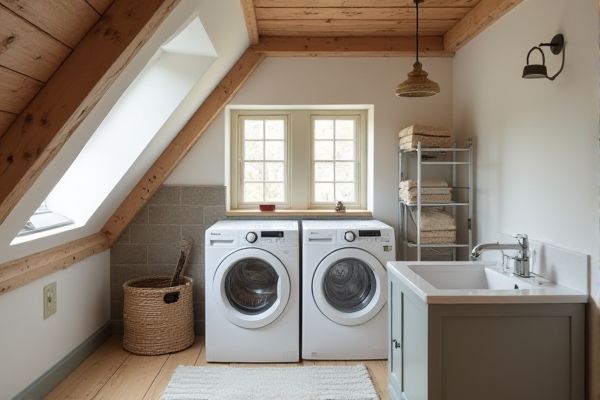
Choosing between attic laundry and basement laundry depends on factors like space utilization, accessibility, and moisture control, with attic setups offering convenience and natural light while basement units provide stable temperatures and ample room. Explore the full article to determine the best laundry location for Your home's needs and maximize efficiency.
Table of Comparison
| Feature | Attic Laundry | Basement Laundry |
|---|---|---|
| Space Utilization | Utilizes underused attic space, often smaller area | Uses basement area, generally larger, more flexible space |
| Accessibility | Requires stairs, may be less convenient | Usually easily accessible from main floor or stairs |
| Ventilation | Poor ventilation; requires enhanced airflow solutions | Better ventilation options; easier to vent dryers and machines |
| Temperature Control | Prone to temperature extremes; needs insulation and HVAC | More stable temperatures; less HVAC required |
| Plumbing & Electrical | May need extensive upgrades; costly to install lines | Typically easier and cheaper to install plumbing/electrical |
| Flood Risk | Minimal risk; located above ground level | Higher risk of flooding; requires waterproofing |
| Noise Impact | Less noise disturbance to living areas | Potential noise closer to living spaces |
| Cost | Higher remodeling and installation costs | Generally lower setup costs |
| Overall Suitability | Best for small homes or limited basement space | Ideal for larger homes with ample basement area |
Introduction to Attic Laundry vs Basement Laundry
Attic laundry rooms capitalize on unused upper-space, offering enhanced natural light and improved ventilation compared to basement setups. Basement laundry areas benefit from cooler ambient temperatures and proximity to existing plumbing and drainage systems. Homeowners must weigh factors like energy efficiency, moisture control, and accessibility when choosing between attic and basement laundry configurations.
Space Utilization: Attic vs Basement
Attic laundry rooms maximize unused vertical space, providing a quiet, secluded area that often remains warmer and dryer than basements, reducing moisture-related issues. Basement laundry spaces benefit from easier plumbing access and cooler temperatures, which can help preserve clothing fibers but may require moisture control solutions. Your choice between attic and basement laundry depends on optimizing available square footage while managing ventilation and humidity for efficient space utilization.
Structural Considerations and Load-Bearing Factors
Attic laundry installations require careful evaluation of roof truss strength and potential reinforcement to support the additional weight of washers, dryers, and water lines. Basement laundry rooms typically benefit from existing robust floor joists designed to bear heavy loads, minimizing structural modifications. Both options necessitate assessing load distribution and moisture-proofing to prevent damage and ensure safety.
Plumbing and Drainage Requirements
Attic laundry installations require careful consideration of plumbing and drainage due to gravity limitations, often necessitating pump systems for wastewater removal. Basement laundry setups benefit from natural gravity drainage, making plumbing connections simpler and more cost-effective. Proper venting and water supply access are critical in both locations to prevent drainage issues and ensure efficient operation.
Energy Efficiency and Ventilation
Attic laundry rooms offer improved energy efficiency due to their natural insulation from surrounding attic spaces, reducing heating and cooling costs compared to basement laundry areas, which often require more energy to maintain a comfortable temperature. Ventilation in attic laundry rooms tends to be better because of proximity to roof vents and windows, allowing moist air to escape more easily, whereas basements may suffer from poor air circulation and higher humidity levels that demand mechanical ventilation. Ensuring your laundry space has proper airflow and temperature control directly impacts energy consumption and helps prevent mold growth.
Accessibility and Convenience
Attic laundry rooms often present challenges in accessibility due to narrow stairways and limited space, making frequent trips with heavy laundry loads more cumbersome. Basement laundry setups typically offer easier access from main living areas, enhancing daily convenience and reducing effort when carrying clothes. Your choice between attic and basement laundry should weigh the ease of access and the practicality of frequent use for optimal household efficiency.
Noise and Vibration Control
Attic laundry installations typically offer superior noise and vibration control due to their separation from main living areas and solid structural framing, which absorbs sound better than basement ceilings. Basement laundry rooms often transmit noise through adjacent living spaces because of thinner floors and shared walls, making soundproofing necessary for comfortable living environments. Using vibration isolation pads and acoustic insulation materials can significantly reduce disruptions in both attic and basement laundry setups.
Safety Concerns and Building Codes
Attic laundry installations pose safety concerns such as increased risk of water damage due to leaks or drainage issues, while basement laundry setups benefit from easier access to existing plumbing and drainage systems, reducing the chances of structural damage. Building codes often require proper ventilation, adequate electrical wiring, and water-resistant materials in both attic and basement laundry areas, but attics typically demand stricter compliance with insulation and moisture control standards to prevent mold growth. Your choice between attic and basement laundry should prioritize adherence to local building codes and mitigating safety risks associated with water exposure and electrical hazards.
Cost Comparison: Installation and Maintenance
Installing a laundry room in the attic typically involves higher costs due to structural reinforcements, plumbing, and electrical work required for elevation, while basement laundry installations generally benefit from existing plumbing but may need moisture control measures. Maintenance expenses in attic laundries can increase because of potential roof leaks and temperature fluctuations affecting appliances, whereas basement laundries face challenges like dampness and mold, necessitating regular humidity management. Overall, basement laundry setups tend to be more cost-effective in both installation and upkeep compared to attic options.
Final Verdict: Choosing Between Attic and Basement Laundry
Attic laundry rooms offer better natural light, reduced noise disturbances, and potential space-saving benefits, making them ideal for homeowners prioritizing brightness and quietness. Basement laundry areas provide cooler temperatures and easier access to plumbing, often resulting in improved appliance efficiency and lower installation costs. Optimal choice depends on specific household needs, structural layout, and desired convenience versus utility efficiency.
 homyna.com
homyna.com